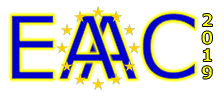Speaker
Description
Accelerators based on LWFA are of great interest for a new generation of compact machines. Choosing external injection of the probe beam in LWFA has the advantage that a well-controlled and fully characterized beam can be injected. The matching of electron bunches into an accelerating wakefield makes high demands on the electron beam quality. The electron beam size must be extremely small to match the tiny plasma channel. The short period of accelerating field in the plasma requires a bunch length in the (sub-)fs range. These electron beam properties result in a high electron density and strongly space charge (sc) dominated bunches. The beamline before the plasma must enable to control the significant effect of sc on the bunch and to transversely match the beam to the plasma. Further constraints to the beamline design are given by the incloupling of the high power laser and the implementation of diagnostic tools. Choosing suitable settings for the beamline elements in order to match the beam, poses a great challenge for the beamline design. Using multi-objective optimization, optimum settings for the beamline elements can be extracted from Pareto optimum solutions. The development of a universal multi-objective optimization algorithm for beamline matching is presented.

